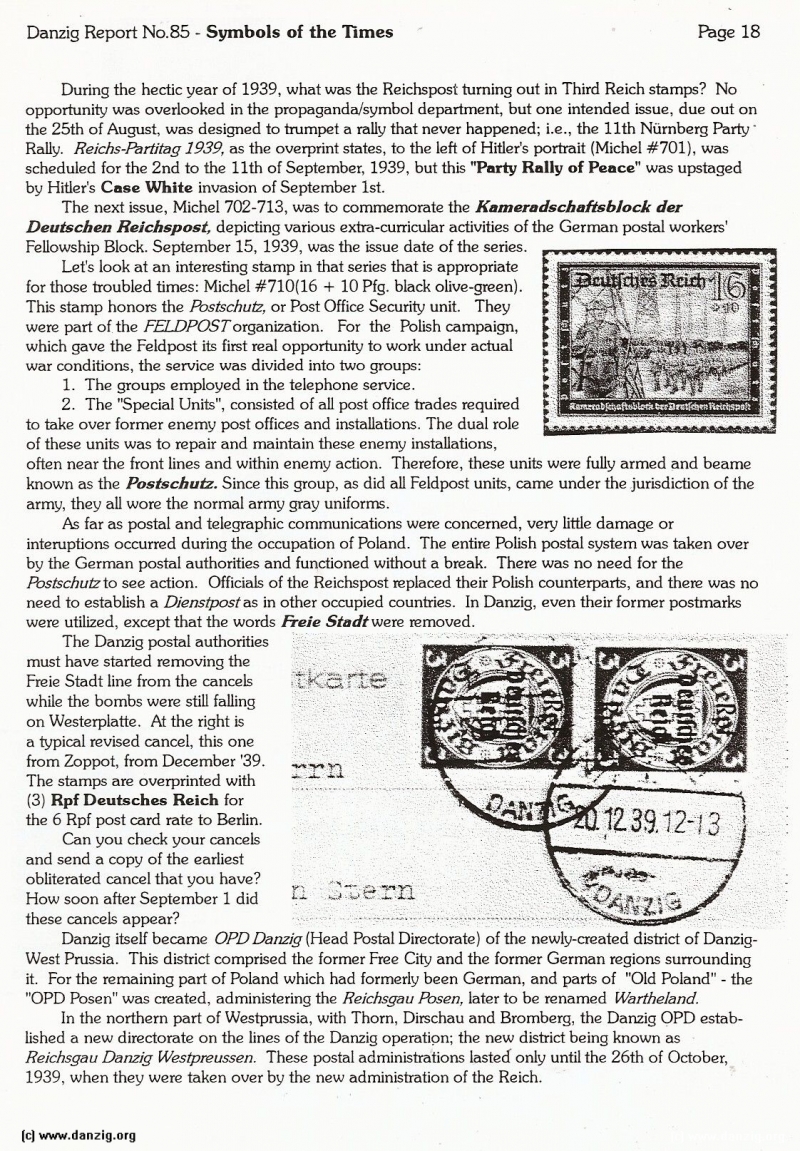
During the hectic year of 1939, what was the Reichspost turning out in Third Reich stamps? No opportunity was overlooked in the propagandaJsymbol department, but one intended issue, due out on the 25th of August, was designed to trumpet a rally that never happened; i.e., the 11th Nurnberg Party Rally. Reichs-Partitag 1939, as the overprint states, to the left of Hitler’s portrait (Michel #701), was scheduled for the 2nd to the 11th of September, 1939, but this “Party Rally of Peace” was upstaged by Hitler’s Case White invasion of September 1st.
The next issue, Michel 702-713, was to commemorate the Kameradscbaftsblock der Deutschen Reichspost, depicting various extra-curricular activities of the German postal workers’ Fellowship Block. September 15, 1939, was the issue date of the series.
Let’s look at an interesting stamp in that series that is appropriate for those troubled times: Michel #710(16 + 10 Pfg. black olive-green). This stamp honors the Postschutz, or Post Office Security unit. They were part of the FELDPOSTorganization. For the Polish campaign, which gave the Feldpost its first real opportunity to work under actual
war conditions, the service was divided into two groups:
1. The groups employed in the telephone service.
2. The “Special Units”, consisted of all post office trades required to take over former enemy post offices and installations. The dual role of these units was to repair and maintain these enemy installations, often near the front lines and within enemy action. Therefore, these units were fully armed and beame known as the Postschutz. Since this group, as did all Feldpost units, came under the jurisdiction of the army, they all wore the normal army gray uniforms.
As far as postal and telegraphic communications were concerned, very liffle damage or interuptions occurred during the occupation of Poland. The entire Polish postal system was taken over by the German postal authorities and functioned without a break. There was no need for the Postschutz to see action. Officials of the Reichspost replaced their Polish counterparts, and there was no need to establish a Dienstpostas in other occupied countries. In Danzig, even their former postmarks were utilized, except that the words Freie Stadt were removed.
The Danzig postal authorities must have started removing the Freie Stadt line from the cancels while the bombs were still falling on Westerplatte. At the right is a typical revised cancel, this one from Zoppot, from December ‘39. The stamps are overprinted with
(3) Rpf Deutsches Reich for the 6 Rpf post card rate to Berlin.
Can you check your cancels and send a copy of the earliest obliterated cancel that you have? How soon after September 1 did these cancels appear?
Danzig itself became OPD Danziq (Head Postal Directorate) of the newly-created district of Danzig- West Prussia. This district comprised the former Free City and the former German regions surrounding it. For the remaining part of Poland which had formerly been German, and parts of “Old Poland” - the “OPD Posen” was created, administering the Reichsgau Posen, later to be renamed Wartheland.
In the northern part of Westprussia, with Thorn, Dirschau and Bromberg, the Danzig OPD establ ished a new directorate on the lines of the Danzig operation; the new district being known as Reichsgau Danzig Westpreussen. These postal administrations lasted only until the 26th of October, 1939, when they were taken over by the new administration of the Reich.
Danzig Report Vol. 1 - Nr. 85 - October - November - December - 1994, Page 18.
Hits: 3290
Added: 10/07/2015
Copyright: 2025 Danzig.org

